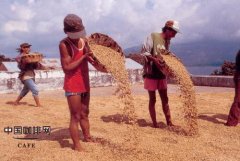A negative example-- Dead beans
In the second half of this year, when we first started baking, we could get in touch with more raw beans, of course, including more defective beans, so we came up with the idea of gradually selecting, understanding, and trying all kinds of defective beans, which could be used in the sensory system to establish a library of negative teaching materials, so we made a screening of the baked beans.
Papua PB
The small box in the picture contains the lighter beans selected, and the color difference is easy to see. Mobile phone shooting, the lighting is not good, so the photo effect is not good, sorry.)
Powder
The second picture is a comparison after grinding into powder. The so-called "dead bean" is very light after grinding, similar to the color of "turmeric powder" in seasoning. Although the picture is not very clear, we can see that the powder on the left is much lighter than that on the right. But these are actually beans baked in the same pot.
With regard to "dead beans", the saying in memory is that the coffee fruit was "ossified" and stopped developing before it was picked during the growth process. So the sugar (sugar?) in beans Very little, then in the baking process, can not fully complete the caramelization reaction, so there is no way to color. But when it comes to raw beans, the difference between them and ordinary beans is not obvious.
Use Aeropress to extract two cups respectively, because of the color difference after making coffee, shooting with mobile phone really can not reflect the effect, so it is not on the picture. Coffee extracted from "dead beans" is redder in color, more like black tea, while coffee extracted from normal beans is of course relatively darker.
The following is about the sensory differences between the two, just for personal feelings, to share with you.
Picked beans, in the smell of beans, there is not much difference, there is still a small difference, but can not describe what kind of smell. After grinding the ingredients, the difference of dry aroma is obvious. The performance of "dead beans" is obvious "roast" smell, reminiscent of all kinds of fried goods, but also with a little "oil" smell, similar to the so-called "ha ha" taste, not very obvious, but there is. On the other hand, normal beans smell sweet, sweet like black sugar or yellow sugar, with a little Italian vinegar, and some may be sour, anyway, they are associated with fruit, but it is not clear what it is, so it is not negative.
Did not do a cup test, directly brew and then drink, the color of "dead beans" is red, there is no obvious sour or bitter, very insipid, more like tea, the aftertaste with some sunflower seeds taste, there is a little melon seed oil taste. Thin texture, no sweet, no astringency.
Normal beans, sour and bitter balance, good sweetness, medium texture +, good taste, long-lasting, no astringent taste.
But that's not what I want to show. Because this bean has been baked many times, I like its bright and lively sour, rising, bright feeling, and almost no bitterness, just sweet and sour. Today, the pace of baking is a little faster. I originally planned to produce the beans about 1 minute after the end of the explosion, but I found that the overall time and the previous baking time was about one minute less. after the explosion, the fire was turned off and stretched to 2 minutes. but the bitterness is still brought out, which I personally don't like very much.
Generally speaking, they are good beans and need to be adjusted the next time they are baked.
In addition: the use of Hario ceramic cone knife hand grinding, grinding strength feedback to the hand, obviously feel that "dead beans" in grinding more laborious, and with a "sticky knife" feeling, different from the crisp performance of normal beans. It is not known that dead beans are not easy to dehydrate or "ossification" in the growth process lead to changes in their density.
Important Notice :
前街咖啡 FrontStreet Coffee has moved to new addredd:
FrontStreet Coffee Address: 315,Donghua East Road,GuangZhou
Tel:020 38364473
- Prev

The purpose of initial processing of coffee
There are many initial processing methods of coffee, which are mainly divided into dry processing, wet processing and semi-dry processing. Here we briefly introduce the first two processing methods.
- Next

Identification of coffee beans good and bad coffee bean grading system defective bean species identification method
Whether the gloss is good, the color is uniform and without spots; smell its fragrance-whether it is fragrant and rich; oral test brittleness-put it into the mouth, whether it is crisp and sound, taste good, and finally see if the bean shape is full and weighty. Because you can't make mellow coffee without good coffee beans / powder.
Related
- Guji coffee producing area of Guji, Ethiopia: Humbela, Shakiso, Wulaga
- What is the most expensive variety of Qiloso in BOP multi-variety group?
- How to store the coffee beans bought home?
- Why are Yemeni coffee beans so rare now?
- Ethiopian Sidamo all Red Fruit Sun Sun Santa Vini Coffee beans
- SOE is mostly sour? What does it mean? Is it a single bean? what's the difference between it and Italian blending?
- Is Italian coffee beans suitable for making hand-brewed coffee?
- How to choose coffee beans when making cold coffee? What kind of coffee beans are suitable for making cold coffee?
- Just entered the pit to make coffee, what kind of coffee beans should be chosen?
- Can only Japan buy real Blue Mountain Coffee? What are authentic Jamaican Blue Mountain coffee beans?

